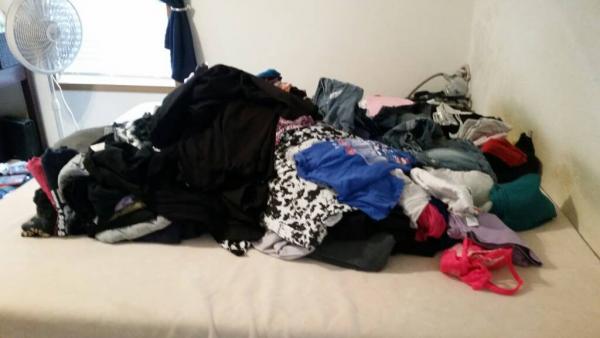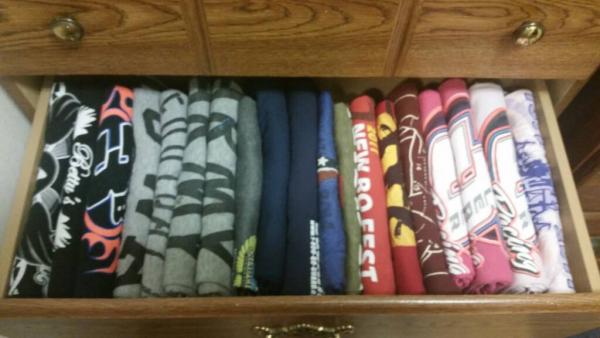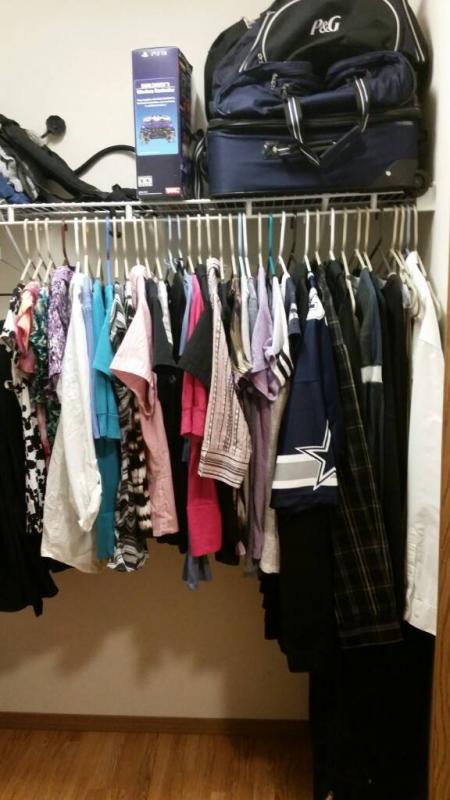Last time, we discussed the different categories of the Konmari process. [Read it here] This time I want to delve deeper into the sorting process.
Let’s start with clothing. Grab all of your personal clothing items. All your tops, bottoms, underwear, shoes, coats, jackets, sweaters, those winter or summer clothes you have packed away in the closet, those bins of clothes you don’t wear anymore because you gained/lost a lot of weight. Everything. Toss it on your bed. Marie says to toss it on the floor, but I don’t agree that this is the best idea. I don’t know about you, but I’d rather not rewash everything that I pulled from my closet. Plus, if you toss it on the bed, you can place your discard items on the floor to be bagged or boxed up later, and you’ll feel the urge to complete this category so you can have your bed back before bedtime. Whether you choose the floor or the bed as your sorting location, be sure to grab everything you own. Tossing all the clothing, coats and shoes in one pile will open your eyes to the sheer volume of clothing you possess.
Your pile may resemble something like this. I was quite surprised by how small my pile was, but I still managed to have 5 black garbage bags of discards to take care of, so apparently there was more there than I thought.

 Now, start sorting by like item. Tops in one pile, jeans and other pants in another pile, dresses or suits in another pile. This is done so you can see the volume of each category of clothing you have.
Now, start sorting by like item. Tops in one pile, jeans and other pants in another pile, dresses or suits in another pile. This is done so you can see the volume of each category of clothing you have.
Once they’re sorted, pick a category to start with – I started with t-shirts. Pick up each article of clothing the assess how you feel by looking at and feeling the item. Do you feel a charge of happiness in your soul when you touch the item? This charge of happiness is a joy spark. I feel mine deep in my chest. If you feel this, then this item is a joy sparker. Do this for every single piece of clothing you own.
Now, one suggestion I found to be kind of kookie in the book was Marie’s suggestion to thank the items you’re discard. She suggests you find some reason to thank every item you no longer love for once being a part of your life. So, thank that dress that hugged your hips just a little bit too much for your comfort for showing you what not to wear. Thank that ratty old t-shirt for so many years of enjoyment. Thank that scratchy sweater for showing you what type of material you do not like.
Marie mentions that all items have a spiritual aspect to them, but I know most people don’t believe in this type of thing. So for those, consider it a lesson in gratitude. Thanking the clothes you do not wish to keep, either vocally or internally, teaches you how to be grateful for all the extras in your life. We live in a world of abundance. We have more clothing than we could ever need to wear, therefore we are blessed beyond measure and thanking those items we chose to discard teaches us to appreciate this abundance and show our gratitude. It will make you a more appreciative person, trust me. You’ll start to appreciate even the most mundane and insignificant items in your life – the rug you wipe your feet on, that pen you write your check with, even that ponytail holder you put in your hair each day. So, thank your discards individually for whatever lesson or joy they brought into your life at one time. It might seem silly, and you may even feel ridiculous thanking a holey pair of old runners, but it truly does provide benefit to your life. Trust me on this.
Next, assess whether or not the joy sparkers fit right. If you love it, but it doesn’t fit right, Marie says you’re supposed to discard it – she says keeping clothes around that don’t fit is one way we live in the past and living in the past is not advised. Embrace now. It’s good to remember the past, but not live there through regret and loss. She suggests that if you love this item that much, you should consider replacing it in a size that does fit. My advice is to sell that item if it’s in a sellable shape, and replace it with the money you make by selling the item. Consignment is a great way to sell items, but so is a garage sale. I would caution you to not keep a huge collection of items to sell on garage sale because you’ll quickly find yourself overcome with a huge pile of things to sell. But if you think you can handle it or if you have a place to store these items that is not inside the four walls of your home, then feel free. Just be sure to donate whatever you don’t sell, rather than keeping it around for the next sale.
Difficult Decision
What happens when you find an item that doesn’t necessarily spark joy, but has significant emotional value to it? The best example of this would be a wedding dress. Marie suggests moving this item to the “Sentimental Category” which is the final category in the Konmari process. Her belief is that sentimental items are very hard to make a concrete decision about because our hearts cloud our judgement. She suggests saving these items for last will allow us to see them through new, unclouded eyes, which will help us properly deal with them. Maybe the sentimental value is negative in nature – sadness or guilt. It’s hard to make decisions about things that hurt our heart in the beginning, so saving them for the sentimental category gives us time to hone our Konmari skills before dealing with these emotionally charged items. For items that don’t have sentimental value and are not joy sparkers, but still cause trepidation when considering discarding them, say because you spent a lot of money on it and never wore it, Marie’s advice is to discard it.
Sometimes we have trouble making the keep or discard decision but it’s not because someone gave it to us or because we spent a lot of money on it. In the book, Marie says we may hesitate on an for one of two reason.
- Fear of the future – ” But, I might need this someday.”
- To preserve the past – “But so-and-so gave this to me when…” (I won’t discuss this in length here because I don’t believe too many articles of clothing fall into this subcategory, but my suggestion here is to spend a bit of time with this item. Reminisce about the event when you received this item. If the item is immediately useful or sparks profound joy in your heart, keep it. If the item is not immediately useful or does not spark joy, discard it. If the item produces significant feelings of nostalgia, take a photograph of the item, thank it for the joy it brought you way back when and for reminding you of the gift giver, and place it in the discard pile).
For anything you come across that you can’t make a decision on, you’re supposed to ask your self what is it about this item that is holding you back from making a decision? The goal here is to dig deep to the root of the indecision. When you answer what is holding you back, she advises you ask another question based on that answer. Keep asking yourself why until you reach the REAL reason you can’t choose between keep and discard. If the real reason ends up being sentimental attachment, move it to the sentimental category and revisit it when you get to that category. If it is not because of sentimental attachment, asking these questions should help you make the decision to keep or discard.
If the bottom line ends up being because the item may be useful “someday”, the suggestion is to discard the item. “Someday” hardly ever comes, and if it does, chances are you’ll be able to replace the item when it’s needed. This applies to things like that cocktail dress you bought when your husband was invited to that swanky dinner party 6 years ago that you’ve never worn since. If you should need a cocktail dress for an event somewhere down the road, chances are you’ll want to buy a new dress anyway, so there’s no reason to hold onto the one you currently have. Gift it to a thrift shop or sell it to a consignment shop and allow it to spark joy in someone else’s life.
But what if you spent a great deal of money on an item and you never used it? How can you discard something you paid so much for but never used? You’ll lose that money! I ran into a couple of items that fall into this category as I went through the process. Truth be told, you’ve already lost the money. You don’t keep that money by keeping the item. The money is already gone. Discard the item without guilt and consider it a learning experience to only buy joy sparkers in the future. Either place the item in your garage sale pile or the donate pile. Someone will be overjoyed to find your item in such great condition at such a bargain price.
Deal with discards immediately
Any items you choose not to keep need to be dealt with – they need to be removed from the house immediately. Bag or box them up immediately and remove them from the house. Take them straight to your car and put them in the trunk. Plan to stop at the thrift shop in the next 24 hours. Do NOT reopen the bag or box and go through the items a second time. Generally, doing this produces a feeling of guilt and causes you to second guess your initial gut decision. Also, do not allow others to look through the bag or box. Doing so will result in responses such as “why are you getting rid of this? It looks so good on you”, which will make you second guess your initial decision. Don’t invite this type of roadblock into your Konmari journey. Trust your initial decision!
Congratulations. You have just completed the Konmari sort on your personal clothing. You will likely notice your pile of clothing has been significantly reduced. This is a tremendous win. Give yourself a pat on the back. You deserve it.
Konmari Folding
So, now that we have sorted out our joy sparkers, it’s time to learn how to properly store these items. Marie has a specific method for folding our joy sparkers so they can be readily accessed. When you fold like she does, you can “file” your clothing in your drawers, which gives you an immediate view of all the times you have stored in the drawer. With Marie’s folding method, there’s no more digging through your drawers to see what shirts are hidden from view. Everything is visible.
I will admit that Marie’s method is a little more time consuming, but when you’ve paired down your shirts to only about 1/5 or 1/4 of what you previously had, the time spent doing laundry in general is reduced significantly, so folding her way doesn’t take any more time than laundry did prior to the sorting process.
The description in the book is a little confusing, I think, so I searched the internet for the proper Konmari fold after reading this section of the book. A good video I found is here. There are videos that address everything from t-shirts to pants to underwear to socks. I’ll let you search for other videos as you need them.
When you are finished folding and putting away your clothing, your drawers and closet may look something like the photo below. See how easy it is to see exactly what I have for shirts? I can see each shirt I own without digging. I can pluck out the shirt I wish to wear without disturbing the others. None of my clothes are getting smashed and wrinkly at the bottom of the pile. Every shirt is able to “breathe” because its friends aren’t sitting on top of it. It’s quite calming, to be honest with you.

Hanging clothes
Some people prefer to hang their clothes, and that’s ok too. Marie’s suggestion for hanging is to place the longest items or those with the heaviest weight fabrics to the left, with the length getting shorter as you move to the right. She also advised placing darker items to the left and lighter to the right. While I can see how this would be visually appealing, that seemed a bit on the excessive side to me, so I didn’t sort my items, but I did sort items by ownership – mine on the left, my husband’s on the right. Hanging them this way has also shown me which items I tend to wear the most and which I don’t wear very often, with items I rarely wear remaining in the middle – this I believe will pave the way for another pass through this category in the future.

Whether you choose to fold or hang your clothes is irrelevant, really. What matters is that you reduce the quantity of clothing you have down to true joy sparkers.
Now is a good time to bring up others who live in your home. At the time that these photos were taken, my husband had not gone through his clothing. Truth be told, he still hasn’t and that’s ok. Not everyone feels the need for decluttering. It’s an issue you may also encounter. It’s important not to nag or push the others to subscribe to this method. With any luck, they’ll come around when they see how successful you have been with your sort.
My Outcome
I tackled this task while I was off work for a 3 day weekend before winter had ended. I expected it to take much longer than it did. Once I got started, I moved quickly from one clothing subcategory to the other. I managed to get all clothes sorted, joy sparkers separated and folded, and discards placed in bags and in my trunk within one day, freeing me to use the rest of the weekend on other categories. I moved on to books that same day, and then CDs. Then I completed the weekend by working through paper. We didn’t have much paper because I have always tried to stay on top of it. That opened the door to taking my time on komono, which took way more time than I anticipated. It’s amazing how many komono categories we have in our homes! To help you think of all your komono categories, here is a good checklist created by some random internet person. I hope it helps you like it did me.
I can assure you my closet still looks the same and it’s been quite a few months since I worked through that category. I’ve even kept up with the folding method Marie recommends and surprisingly enough, I actually enjoy folding laundry now. It’s calming, believe it or not. I went from keeping 6 laundry baskets of clothes piled up in my dining room to keeping them empty and in my laundry room.
Getting dressed in the morning is so quick now! Picking out my clothes no longer has to be done the night before because it literally takes seconds to grab a shirt and a pair of pants and put them on. I no longer stand in my closet milling over what I want to wear, pulling out things that don’t really fit and wasting time trying them on only to remove them again and dig around for something else. I know everything in my closet fits. I know everything I have hung up looks good on me and makes me feel comfortable.
I’ve since helped my children (8 and 5) go through their clothing to weed out the joy sparkers for proper folding and storage. My 5 year old easily and quickly makes a clothing decision each morning – I ask her if she wants to wear a dress or a shirt. She answers and then goes straight to her dresser to pick out what she wants (yes, her dresses are folded and in her drawer with her shirts and pants). My 8 year old no longer asks where he can find his clothes. He knows they’re folded up nicely in his dresser.
If your family is anything like our family was prior to Konmari, choosing what to wear each day is an exercise is frustration and a huge time sucking task that involves sorting through laundry baskets to find the necessary clothing pieces. Completing this category has completely transformed our mornings and made them a little less hectic, a little less frustrating, and a little more relaxing. It is my belief that once you complete this category, your mornings will improve as well. Check in with me after you sort your clothes and tell me how it went. I’d love to hear.






